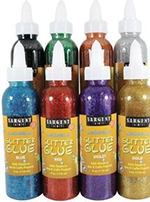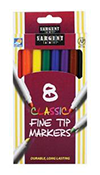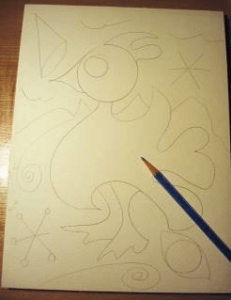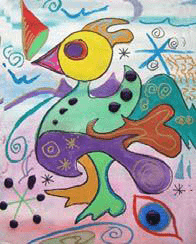Goal (Terminal Objective):
Design, Painting
Objective:
Students will demonstrate the ability to organize knowledge and ideas for the expression and production of art. Students will identify the sources for art expression and describe the processes artist use in developing their ideas.
National Standards:
Visual Arts Grades K-5 Content Standard 1: Understanding and applying media, techniques, and processes
Visual Arts Grades K-5 Content Standard 4: Understanding the visual arts in relation to history and cultures
Visual Arts Grades K-5 Content Standard 5: Reflecting upon and assessing the characteristics and merits of their work and the work of others
Purpose:
Students will compare and contrast artworks of realism with artworks depicting fantasy. Students will analyze the application color in watercolor techniques. Students will create a work of fantasy art in the style of Miro. Students will create a title and a narrative inspired by their artwork.
New Vocabulary:
wash, technique, dry brush, realism, fantasy, narrative, background, foreground, pattern, symbols, tints, shades, transparent, stylized, imaginative, opaque, gradient
Materials:

#22-1908 Individual Color Washable Glitter Glue set

#22-8423 Art-Time Premium Half-Pan Watercolor Set

#22-1540 Classic Fine Tip Peggable Carton Markers

#22-1506 Metallic Medium Point Peggable Carton Markers

#23-5026 25 sheet Watercolor Pad

#22-7244 144ct. Graphic Pencils
Time:
This lesson may be modified from one to five hours, depending upon the size and complexity of expectations.
Introduction and Motivation (Set):
View referenced websites to analyze exemplars of a variety of artworks using Realism or Fantasy, focusing on the work of Miro. (The work of Alexander Calder may be used as an art exemplar for Fantasy in the sculptural art form.)
Instruction:
View works of Miro. Describe him as a Dutch artist who loved to create paintings of imaginative places, people, and things.
Compare and contrast art exemplars of realism with those of Miro’s fantasy art.
Define fantasy art as an imaginative artwork which is made up and not meant to look realistic. Discuss how Miro created artworks illustrating make-believe places, animals, and/or people. List the types of lines used by Miro.
Describe the shapes used by Miro.
Identify areas where students see repetition of art elements.
Describe how Miro used pure colors and specific shapes to depict an imaginative work of art. Demonstrate a gradated watercolor wash. Compare and contrast the watercolor wash technique with opaque application and with dry brush technique.
Activities:
(1) GuidedPractice:
- Students will create a pencil drawing on watercolor paper (11” x 18”) of a fantasy figure inan imaginative environment inspired by the work ofMiro.
- Students are asked to consider specific symbols used by Miro in his fantasy art and replicate those motifs within their fantasydrawing.
- Students create a gradient watercolor wash background using colors of their choice over the entire paper. (Pencil drawing will show through the transparentwash.)
- Students will utilize watercolor techniques to complete thepainting.
- Students will use markers and glitter glue to embellish their work ofart.
(2) Independent Practice and Check for Understanding: Teacher circulates among working students visually recording students demonstrating understanding of objectives and providesreinforcement.
- Students create sketches of a variety of linear items such as wires, telephone poles, items within the art room,etc.*
- Students use pencil drawing techniques to create a fantasy figure and landscape. Students use a variety of motifs similar to Miro’s to create visualinterest.






- Students use a variety of colors to create visual interest in a transparent gradated watercolor wash.

- Students paint their figures using watercolor, layering transparent washes and implementing some opaque areas andshapes.

- Students use Classic fine tip markers and/or glitter glue to outline figures and adddetails.

- Students will title their artwork and write a short narrative about theirimagery.
(3) Closure: Students record, either by checklist or writing prompt, the symbols used, the connection to the exemplar, and the innovations they provided to thepiece.*
Evaluation:
Teacher/student critique. Individual Evaluation.
Extension:
This strategy may be extended into a three-dimensional artwork.
Resources:
http://en.wikipedia.org/wiki/Joan_Mir%C3%B3
http://www.artcyclopedia.com/artists/miro_joan.html
http://www.artchive.com/artchive/M/miro.html
http://www.artchive.com/artchive/M/miro.html
Art Consultant



